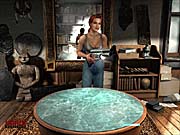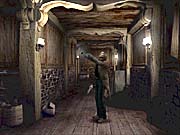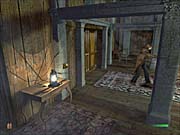In the early '90s, something happened that changed computer gaming forever. It's an upheaval that can be traced to a single focal point: France. In games like Out of This World, Flashback, and Alone in the Dark, French game developers created an entirely new genre--the action-adventure game--and opened new vistas for future game developers to explore. But while Out of this World and Flashback featured stunningly lifelike animation, polygon graphics, and environment-based puzzles, it was the original Alone in the Dark that left the most lasting impression on gaming. Inspired by the horror stories of H.P. Lovecraft and featuring a constantly shifting cinematic third-person perspective, Alone in the Dark's blend of gunplay, tension-filled exploration, 3D characters, and intricate puzzles made it an instant classic. It's been six years since the previous Alone in the Dark game, so longtime fans of the series have every right to expect a top-notch product that melds the latest in graphics with the same sort of atmosphere and gameplay that made the original a classic. Unfortunately, everything about this new game--from its infuriating save-game system to its awkward keyboard controls--shows that it was primarily designed for video game systems, which it was. It's a clumsy port, but what's even more disappointing is that it's a clumsy port of only a middling console game.

Though the game's resolution is locked at 640x480, the in-game graphics are generally crisp and convincing, and have plenty of detail and good lighting effects. The only exceptions are the game's washed-out skyscapes and inexplicably blurry close-ups of inventory items such as maps, blueprints, and photos. Also, the video used in the intro is extremely lackluster--the whole thing looks as though someone smeared petroleum jelly over the camera--but at least the characters' lips move when they speak in this sequence; during the rest of the game their mouths are locked shut as they carry on conversations.
In The New Nightmare, Infogrames has abandoned the 1930s ambience of the first three Alone in the Dark games for a present-day setting in which you play as either private eye Edward Carnby or anthropologist Aline Cedrac. You might think these two might have a rendezvous with Scooby Doo since they're both headed for Shadow Island, a moniker almost as cheesy as the game's subtitle. Cedrac's been sent by a couple of shadowy figures to assist Professor Obed Morton in the translation of some tablets left by a tribe of Native Americans called the Akbanis, and to ensure she makes the trip, her contacts have given her reason to suspect Morton might actually be the father she never met. Carnby's ostensibly tagging along to watch over Aline, but he also wants to find out more about the death of his friend Charles Fiske, who was found dead off the coast of Shadow Island. After their plane mysteriously crashes, the two are separated, and the game proper begins.

Carnby and Aline are both cut from the standard video game character cloth: Carnby's flowing hair and trench coat make him look like The Crow minus makeup, while Aline is a busting-out babe who was poured into her jeans and tank top. Each character takes a different path to the game's finale: As Carnby you'll spend much more time fighting, while Aline has more puzzles to solve. Although you communicate with the other character from time to time via walkie-talkie, these are generally scripted events--the only time you actively use the walkie-talkie is during a silly puzzle in which Carnby must follow Aline's directions and radio back what he sees. Unfortunately, this is also where you'll encounter a bug: If you use the menu system to access the radio, Carnby can't contact Aline; you instead must use the radio hotkey to get past the scene.
You play from the same type of constantly changing third-person perspective that debuted in the original Alone in the Dark--which means the same problems with combat and exploration that were lodged against that game are still intact all these years later. That is, it's too easy to get trapped in a spot where you can't see what your character's doing, and the keyboard-only control (you can use the mouse only for a third-person "free-look" and to aim and fire weapons while stock-still) means you'll watch in agony as your character slowly turns around to face an attacker. Also, the decision to use the same key for actions (opening doors, picking up objects) and firing weapons means you can accidentally pop off a round as you explore with your gun in the aiming position. That's not good, since ammo can be a scarce commodity for Aline.
Even if the combat interface were flawless, it still wouldn't offer a lot to get excited about. Except for zombies and a couple of boss monsters, the polygonal creatures cruising around Shadow Island simply aren't very terrifying. Success in combat is merely a matter of turning quickly enough to aim and having enough ammo to pump into your target. But that first part is harder than it sounds: The designers apparently decided the only way to give the monsters a fighting chance was to have them materialize out of thin air behind you or to plop them directly behind doors so they'll be on top of you the moment you enter a room. It's true you'll probably start the first time a monster appears out of nowhere, but shocks aren't the same as suspense, and these encounters quickly turn into dull surprises--just another event to deal with. Further deadening any sense of tension are the game's mediocre voice characterizations. When you hear Aline say "It seems that Alan Morton is...diabolic. Yes, that's the word!" or the witch doctor Edenshaw mumbling his lines, you won't exactly be engaged in the story. Thankfully you can turn off the dreadful soundtrack, which veers between 1960s Hammond-organ soap-opera music and primitive, grating synthesizer riffs.

Exploration in the game isn't exactly enjoyable either. Despite the presence of glowing orbs that indicate where important items are located, you'll still find yourself painstakingly scouring every nook and cranny using what the box refers to as "sophisticated flashlight technology"--that is, a flashlight--for that one missing item or hidden device you're having trouble finding because of the switching perspective. Poor collision detection means you can get stuck on invisible barriers that surround plants and furniture or get lodged in what seems to be an open doorway. What's even more maddening is having to find just the right spot you need to be in to push an object or pick up an item. At the start of the game, for example, Aline tells Carnby to push a dresser aside so he can enter a bedroom. I spent a good five minutes hitting the spacebar and manipulating the directional arrows just to pull off this simple little maneuver. And it took nearly 15 minutes just to coax Carnby into pushing a statue along a walkway later in the game. The challenge should be in figuring out you need to push something, not in performing keyboard acrobatics just to make it happen.
Yet perhaps the most disappointing aspect of the gameplay is in all the backtracking you must perform. When you play as Carnby, the game might as well be called Keyquest, since the bulk of his adventure is spent finding keys and then returning to see if they open locked doors, cabinets, or chests you stumbled across earlier. When he finally does move outside the Morton mansion and nears the conclusion of the game, the pacing once again slows down as he's forced to work his way through a maze that's chockfull of monsters (and which looks like a rip-off of H.R. Giger's visual designs for Aliens). Even with all the legwork, Carnby's game is rather short, and even shorter if you decide the finale isn't worth navigating that tacked-on maze.
Aline's game lasts longer, and she doesn't get the chance to test out as many keys as Carnby. Her biggest challenge is building a high-tech drilling machine from almost indecipherable blueprints, but even she doesn't solve puzzles as much as engage in aerobic exercise. While exploring a fort near the Morton mansion, you must guide her from top to bottom of the massive castle several times in search of important items--and on the final trip to the basement you must defeat a boss monster in a silly timed battle before racing downward against another timer, as a host of creatures blocks your path.
You can't help but wonder if these sequences were included to make a short game longer, a sense that's bolstered by other frustrating problems. You can't bypass cinematic cutscenes (you can only skip one character's lines at a time), you can't stop a long-winded tape recording, and I won't even go into the numerous and consecutive ladders you must watch Aline climb despite the fact that the game pauses and asks if you want her to climb the ladder. If the game asks, why not just make her appear at the top or bottom after you consent?

The horrendous save-game feature makes all this even more frustrating. The manual says, "The actions you previously carried out in the room you save in must be redone," which is a fancy way of saying that saving a game resets the entire level. If Carnby dies fighting a midgame boss in the library, it takes you about two minutes to run around and do everything needed to try again even if you saved just before the battle began. If the timer expires during Aline's mad dash to the basement, you've got to repeat the process from scratch. There are only four save-game slots and no way to name a saved game; there's not even a picture for saves, just a terse location description (lobby, west bedroom). Whether it's the result of laziness or indifference, this is the kind of stuff that gives console ports a bad rap among PC game players.
Alone in the Dark: The New Nightmare has its moments, particularly in its story. But in the end, about the only noticeable improvement it offers over its predecessors is in its graphics--and you should expect more than that for your money.